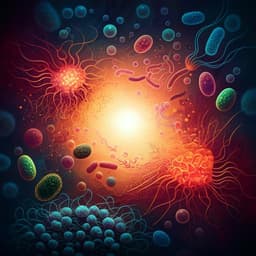
Biology
Metabolic cross-feeding in imbalanced diets allows gut microbes to improve reproduction and alter host behaviour
S. F. Henriques, D. B. Dhakan, et al.
This innovative study reveals how gut microbes work together to boost the reproductive success and eating habits of Drosophila melanogaster. Conducted by a team of researchers including Sílvia F. Henriques and Carlos Ribeiro, the findings highlight the crucial role of metabolic interactions in microbiome resilience.
~3 min • Beginner • English
Introduction
Dietary amino acids (AAs), particularly essential amino acids (eAAs) that cannot be synthesized by animals, are critical determinants of health, lifespan, and fitness. In Drosophila melanogaster females, deprivation of any one of the 10 eAAs or mating induces neuronal changes that increase protein appetite, yet mechanisms controlling nutrient-specific appetites remain unclear. The gut microbiome influences host feeding behavior and reproduction, generally acting as a community rather than as isolated species. Host diet rapidly reshapes microbiota composition, and nutrition-microbiome interactions are personalized and complex. A key challenge is to map microbial metabolic interactions that confer resilience to dietary perturbations and determine how these interactions modulate host physiology and behavior. Drosophila, with its simple, cultivable microbiome dominated by Acetobacter and Lactobacillus, and amenable gnotobiotic and isotope-tracing approaches, provides a powerful model. This study investigates how a minimal community of Acetobacter pomorum (Ap) and Lactobacillus plantarum (Lp) suppresses protein appetite in eAA-deprived flies, dissects their metabolic cross-feeding under defined holidic diets, and identifies the microbial and metabolic determinants that alter host feeding decisions and reproduction.
Literature Review
Prior work shows diet rapidly and reproducibly alters the human gut microbiome; microbial communities, rather than single strains, often drive host physiological effects. Lactic acid bacteria commonly co-occur with other microbes across niches, including the Drosophila gut where Acetobacteraceae and Lactobacilli are frequent co-residents. Lactobacilli often lack biosynthetic genes for essential nutrients and rely on environmental uptake, whereas Acetobacteraceae can utilize diverse carbon sources and have been implicated in amino acid biosynthesis using organic acids. Microbial cross-feeding, including exchange of amino acids or vitamins via secreted metabolites or nanotubes, can sustain community growth under nutrient limitation and has been proposed to modulate host functions (e.g., production of GABA, serotonin, or short-chain fatty acids acting on host GPCRs). Holidic diets in flies have enabled precise nutrient manipulation to study appetite control and microbiome effects on feeding and reproduction. However, the mechanisms by which specific metabolic interactions within a minimal gut community buffer dietary imbalances and alter host behavior remained unresolved.
Methodology
- Model and diets: Adult Drosophila melanogaster females maintained on chemically defined holidic media (HM), including complete HM and versions lacking individual eAAs (notably isoleucine, Ile, and histidine, His). Gnotobiotic protocols generated germ-free (axenic), monoassociated (Ap or Lp), and biassociated (Ap+Lp) flies.
- Bacterial strains and genetics: Acetobacter pomorum and Lactobacillus plantarum strains cultivated; a Lactobacillus plantarum WCFS1 ΔldhDΔldhL mutant deficient in lactate dehydrogenases used to test lactate necessity; parental WCFS1 served as control.
- In vivo behavior: Protein appetite assessed by flyPAD-based sip counts on yeast, comparing conditions (complete HM vs -Ile or -His; GF vs mono- vs biassociation; and lactate supplementation). Statistical tests included Dunn’s multiple comparison and Kruskal–Wallis tests.
- Reproduction: Egg laying assays on apple juice agar plates after dietary and microbial manipulations; heat-killed (HK) bacterial biomass treatments tested contribution of biomass to egg laying under -Ile conditions.
- In vivo bacterial loads: Colony-forming units (CFUs) per fly quantified after surface sterilization and homogenization; selective plating for Ap and Lp.
- In vitro growth and co-culture: Liquid holidic media variants (complete and -Ile/-His) used to culture Ap and Lp alone or together; CFUs measured over time (0–72 h) to assess growth and cross-feeding capacity.
- Isotope-resolved metabolomics: Stable isotope tracers used to map metabolic fluxes. Conditions included HM with uniformly 13C-glucose or uniformly 13C-lactate. Supernatants collected at 24 and 48 h for LC–MS to quantify labeled isotopologues of amino acids (e.g., Ile m+2 to m+6) and lactate. Mean percent enrichment (MPE) computed. Data corrected for natural isotope abundance (isocor) and normalized to growth (OD600). Genome-based pathway reconstruction (KEGG/ BioCyc) of Ap enzymes supported proposed aspartate-derived biosynthetic route from lactate to Ile.
- Metabolomics in flies: Targeted metabolomics on isolated fly heads (GF vs bacteria-associated; complete vs -Ile diets) to quantify free AAs and degradation products.
- Data analysis: LC–MS preprocessing in XCMS with optimized parameters (e.g., CentWave peak picking; retention time correction), plotting in R/ggplot2; statistical analyses in GraphPad Prism for behavioral and growth data. Source data and Supplementary Data include metabolite levels before/after corrections.
Key Findings
- Community-dependent suppression of protein appetite: Biassociation with Ap+Lp significantly suppresses yeast appetite in eAA-deprived females, whereas monoassociation with either species alone does not (Fig. 1a). This indicates a minimal two-member community is required to alter feeding behavior.
- Cross-feeding overcomes Lp auxotrophy: Lp fails to grow in -Ile medium alone but grows efficiently when co-cultured with Ap both in vivo and in vitro, demonstrating Ap supplies the limiting eAA (Ile) to Lp (Fig. 2b). Lp titers are lower in -Ile than complete medium, indicating partial compensation.
- Ap synthesizes and secretes eAAs in presence of Lp: Isotope tracing with 13C-glucose shows Ap in co-culture with Lp accumulates labeled Ile isotopologues in supernatant with substantial enrichment (e.g., Ile MPE at 24 h ≈ 36.56% ± 3.32; Fig. 3). Multiple other AAs show increased synthesis/secretion in co-culture compared to Ap alone.
- Lactate is necessary and sufficient: Lp-derived lactate is produced from glucose in co-culture and is critical for the behavioral effect. An Lp ΔldhDΔldhL mutant fails to suppress yeast appetite when paired with Ap, but exogenous lactate restores suppression (Fig. 4a). Replacing Lp with lactate in Ap-associated flies suffices to reduce yeast appetite (Fig. 4b), demonstrating lactate’s necessity and sufficiency in presence of Ap.
- Lactate fuels AA synthesis by Ap via an aspartate-derived pathway: Using uniformly 13C-lactate, Ap synthesizes labeled Ile with enrichment comparable to the co-culture with 13C-glucose (Ile MPE ≈ 35.95% ± 1.27; Fig. 5a) and produces multiple other AAs. Isotopologue patterns (dominant m+2) and pathway reconstruction support an aspartate-derived route from lactate (via pyruvate → TCA → oxaloacetate → aspartate → Ile), with predicted enzymes present in Ap.
- Bacterially supplied AA amounts are too low to directly drive behavior: The amount of Ile secreted by the community in -Ile conditions is ~1/85 of that present in complete HM (Fig. 6a). Behavioral titration shows ≥50% of full dietary Ile is required to suppress protein appetite, whereas 25% is insufficient (Fig. 6b), indicating secreted AAs are ~100-fold too low to explain appetite suppression.
- Reproduction vs behavior dissociated: Despite not altering feeding via AA supply, the Ap/Lp community (and even HK bacterial biomass) modestly rescues egg laying in -Ile females (Fig. 6c), consistent with limited AA provision supporting reproduction. Free AAs depleted from diet were not detectably restored in fly heads, suggesting supplied AAs are funneled to egg production rather than circulating pools.
- Community resilience to diet: Cross-feeding establishes a “circular economy”: Lp provides lactate → Ap uses lactate to synthesize eAAs → AAs support Lp growth and lactate production, buffering the community against dietary imbalances while enabling Ap to modulate host behavior.
Discussion
The findings reveal that a minimal gut bacterial community achieves functional resilience to host dietary imbalances through syntrophic cross-feeding. Lp’s auxotrophy for Ile is compensated by Ap, which increases AA synthesis and secretion specifically in the presence of Lp. Lactate emerges as the key metabolite: produced by Lp, necessary and sufficient for Ap-dependent suppression of protein appetite, and serving as a carbon precursor for Ap’s synthesis of multiple AAs via an aspartate-derived pathway. This cross-feeding sustains community growth under eAA deprivation, ensuring a stable microbial output that can influence host physiology. Crucially, the behavioral effect is not due to direct restoration of dietary eAAs, given the orders-of-magnitude gap between bacterially secreted AAs and the concentrations required to suppress protein appetite. Instead, Ap likely alters host feeding via one or more lactate-derived metabolites that act on host neural or metabolic circuits. Meanwhile, limited AA provisioning by the community can modestly improve reproduction (egg laying), demonstrating a functional separation between microbial effects on behavior and reproduction. Overall, these results underscore the importance of considering microbial community interactions and dietary context when interpreting microbiome effects on the host and highlight mechanisms by which gut communities maintain influence despite fluctuating diets.
Conclusion
This study elucidates a concrete mechanism of metabolic cross-feeding within a minimal Drosophila gut community that shapes host behavior and reproduction under dietary imbalance. Lactobacillus plantarum provides lactate, which Acetobacter pomorum uses to synthesize essential amino acids through an aspartate-derived pathway. This syntrophy enables Lp to overcome Ile auxotrophy, promotes community resilience to eAA-deprived diets, and allows Ap—given lactate—to suppress protein appetite without relying on bulk AA provisioning. The microbiome thereby maintains a steady influence on host physiology, modestly supporting egg laying while independently modulating feeding decisions via lactate-dependent factors. Future work should genetically validate Ap’s proposed biosynthetic pathway, identify the specific lactate-derived metabolite(s) mediating behavioral changes, and assess the generality of these mechanisms in more complex vertebrate microbiomes.
Limitations
- Mechanistic mediator(s) of behavior remain unidentified; evidence suggests lactate-dependent, Ap-derived metabolite(s), but specific molecules and host receptors/pathways are not defined.
- Proposed Ap aspartate-derived pathway is supported by isotope patterns and genome annotations, yet requires genetic validation via targeted knockouts/enzymatic studies.
- Quantification shows bacterially secreted AAs are low; in vivo fluxes, spatial gradients, and host uptake dynamics may differ but were not directly measured in gut compartments.
- Drosophila’s simple microbiome enhances tractability but may not capture the full complexity and redundancy of vertebrate microbiomes; translation requires caution.
- Some methodological text indicates variability/typos; despite that, core conclusions rely on multiple orthogonal assays (behavior, CFUs, isotope tracing) but could benefit from additional in vivo metabolite measurements in gut tissues and neural circuits.
Related Publications
Explore these studies to deepen your understanding of the subject.







